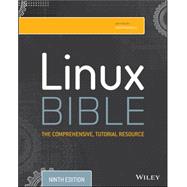Linux Bible, 9th Edition is the ultimate hands-on Linux user guide, whether you're a true beginner or a more advanced user navigating recent changes. This updated ninth edition covers the latest versions of Red Hat Enterprise Linux 7 (RHEL 7), Fedora 21, and Ubuntu 14.04 LTS, and includes new information on cloud computing and development with guidance on Openstack and Cloudforms. With a focus on RHEL 7, this practical guide gets you up to speed quickly on the new enhancements for enterprise-quality file systems, the new boot process and services management, firewalld, and the GNOME 3 desktop. Written by a Red Hat expert, this book provides the clear explanations and step-by-step instructions that demystify Linux and bring the new features seamlessly into your workflow.
This useful guide assumes a base of little or no Linux knowledge, and takes you step by step through what you need to know to get the job done.
- Get Linux up and running quickly
- Master basic operations and tackle more advanced tasks
- Get up to date on the recent changes to Linux server system management
- Bring Linux to the cloud using Openstack and Cloudforms
Linux Bible, 9th Edition is the one resource you need, and provides the hands-on training that gets you on track in a flash.








